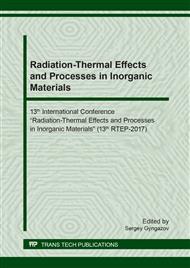[1]
F. Zhou, L. Wei, K. Chen, J. Chen, Analyses of cascading failure in mine ventilation system and its effects in a serious mine gas explosion disaster, Journal of Failure Analysis and Prevention, 13 (2013) 538-544.
DOI: 10.1007/s11668-013-9726-x
Google Scholar
[2]
PB 05-618-03, Rules of safety in coal mines, Moscow, (2003).
Google Scholar
[3]
B.D. Bekirbaev, The fight against coal and rock dust in mines, Gosgortehizdat, Moscow (1959).
Google Scholar
[4]
Y.А. Tolchenkin, The role of retraining of managers and specialists in improving industrial safety in the mines of the industry, Ugol 10 (2007) 41-44.
Google Scholar
[5]
I.I. Mohnachuk, Safety issues at coal mining enterprises, Ugol 2 (2008) 21-26.
Google Scholar
[6]
К.А. Lebetski, S.B. Romanchenko, Dust explosion hazard of mining industry, Gornoe delo, Moscow, (2012).
Google Scholar
[7]
M. Hertzberg, K.L. Cashdollar, D.L. Ng, R.S. Conti, Domains of flammability and thermal ignitability for pulverized coals and other dusts: Particle size dependences and microscopic residue analyses, Symposium (International) on Combustion 19 (1982).
DOI: 10.1016/s0082-0784(82)80293-2
Google Scholar
[8]
GOST 12.1.044-89, Оccupational safety standards system. Fire and explosion hazard of substances and material, Nomenclature of indices and methods of their determination.
Google Scholar
[9]
А.I. Sechin, Installation for investigation of concentration limits of flame propagation of vapor-gas mixtures under different conditions, Izvestiya TPU 258 (1976) 26–27.
Google Scholar
[10]
Y.A. Amelkovich, O.B. Nazarenko, A.I. Sechin, K.O. Fryanova, Investigation of dependence between thermal stability for nanodispersed metals and velocity of flame spreading and time storage, Applied Mechanics and Materials 682 (2014) 357-362.
DOI: 10.4028/www.scientific.net/amm.682.357
Google Scholar
[11]
I.A. Zlochower, G.M. Green, The limiting oxygen concentration and flammability limits of gases and gas mixtures, Journal of Loss Prevention in the Process Industries 22 (2009) 499-505.
DOI: 10.1016/j.jlp.2009.03.006
Google Scholar
[12]
F. Zhao, W.J. Rogers, M.S. Mannan, Experimental measurement and numerical analysis of binary hydrocarbon mixture flammability limits, Process Safety and Environmental Protection 87(2) (2009) 94-104.
DOI: 10.1016/j.psep.2008.06.003
Google Scholar
[13]
H. Le, S. Nayak, M.S. Mannan, Upper flammability limits of hydrogen and light hydrocarbons in air at subatmospheric pressures, Industrial and Engineering Chemistry Research 51 (2012) 9396-9402.
DOI: 10.1021/ie300268x
Google Scholar
[14]
H. Le, Y. Liu, M.S. Mannan, Lower flammability limits of hydrogen and light hydrocarbons at subatmospheric pressures, Industrial and Engineering Chemistry Research 52 (2013) 1372-1378.
DOI: 10.1021/ie302504h
Google Scholar
[15]
M. Gerstein, W.B. Stine, Analytical criteria for flammability limits, Symposium (International) on Combustion 14 (1973) 1109-1118.
DOI: 10.1016/s0082-0784(73)80100-6
Google Scholar
[16]
C.K. Law, F.N. Egolfopoulos, A unified chain-thermal theory of fundamental flammability limits, Symposium (International) on Combustion 24 (1992) 137-144.
DOI: 10.1016/s0082-0784(06)80021-4
Google Scholar
[17]
F.J. Higuera, V. Muntean, Effect of radiation losses on very lean methane/air flames propagating upward in a vertical tube, Combustion and Flame. 161 (2014) 2340-2347.
DOI: 10.1016/j.combustflame.2014.02.013
Google Scholar
[18]
V. Muntean, F.J. Higuera, Upward Propagation of Very Lean Methane-Air Flames in Vertical Tubes, Flow, Turbulence and Combustion 96 (2016) 263-277.
DOI: 10.1007/s10494-015-9661-x
Google Scholar
[19]
N.S. Belyakov, V.I. Babushok, S.S. Minaev, Influence of water mist on propagation and suppression of laminar premixed flame, Combustion Theory and Modelling 22(2) (2018) 394-409.
DOI: 10.1080/13647830.2017.1422543
Google Scholar
[20]
V.A. Arkhipov, Y.F. Patrakov, A.I. Sechin, A.A. Sechin, A.S. Usanina, Method of Comprehensive Assessment of Efficiency of Decrease of Fire and Explosion Risk of Coal Suspended Particles, MATEC Web of Conferences 72 (2016) 01002.
DOI: 10.1051/matecconf/20167201002
Google Scholar
[21]
M. Thomsen, D.C. Murphy, C. Fernandez-pello, D.L. Urban, G.A. Ruff, Flame spread limits (LOC) of fire resistant fabrics, Fire Safety Journal 91(2017) 259-265.
DOI: 10.1016/j.firesaf.2017.03.072
Google Scholar


